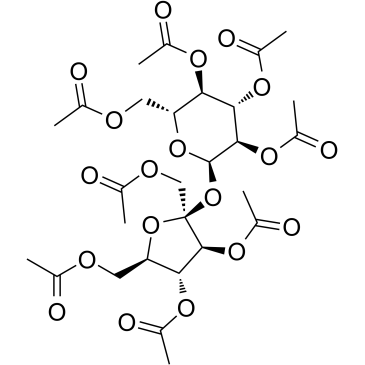Sucrose octaacetate

Sucrose octaacetate structure
|
Common Name | Sucrose octaacetate | ||
|---|---|---|---|---|
| CAS Number | 126-14-7 | Molecular Weight | 678.590 | |
| Density | 1.4±0.1 g/cm3 | Boiling Point | 668.3±55.0 °C at 760 mmHg | |
| Molecular Formula | C28H38O19 | Melting Point | 82-85 °C(lit.) | |
| MSDS | Chinese USA | Flash Point | 275.0±31.5 °C | |
|
Stimulation of the extracellular Ca²⁺-sensing receptor by denatonium.
Biochem. Biophys. Res. Commun. 416(3-4) , 433-6, (2011) The extracellular Ca(2+)-sensing receptor (CASR) is a promiscuous G-protein-coupled receptor closely related to the taste receptors T1R1-T1R3. Here we analyzed the possibility that apart from being stimulated by external Ca(2+) and amino acids, the substances... |
|
|
Gustatory responsiveness to six bitter tastants in three species of nonhuman primates.
J. Chem. Ecol. 35(5) , 560-71, (2009) Gustatory responsiveness of six adult squirrel monkeys, four spider monkeys, and five pigtail macaques to six bitter tastants was assessed in two-bottle preference tests of brief duration (2 min). Animals were given the choice between a 30-mM sucrose solution... |
|
|
B6-MSM consomic mouse strains reveal multiple loci for genetic variation in sucrose octaacetate aversion.
Behav. Genet. 41(5) , 716-23, (2011) Based on crosses among inbred strains derived principally from M. m. domesticus, sucrose octaacetate (SOA) aversion in laboratory mice has been thought for many years to be controlled by a single genetic locus (Soa) located on distal chromosome (Chr) 6. To ex... |
|
|
Soa genotype selectively affects mouse gustatory neural responses to sucrose octaacetate.
Physiol. Genomics 5(4) , 181-6, (2001) In mice, behavioral acceptance of the bitter compound sucrose octaacetate (SOA) depends on allelic variation of a single gene, Soa. The SW.B6-Soa(b)congenic mouse strain has the genetic background of an "SOA taster" SWR/J strain and an Soa-containing donor ch... |
|
|
Examination of glass transitions in CO(2)-processed, peracetylated sugars using sum frequency generation spectroscopy.
Langmuir 22(17) , 7324-30, (2006) The present study utilizes vibrational sum frequency generation (SFG) spectroscopy to study changes in the surface crystallinity of various peracetylated sugars, a class of materials that have a high affinity for carbon dioxide (CO(2)). Studies of the solid-a... |
|
|
High resolution 1H NMR structural studies of sucrose octaacetate in supercritical carbon dioxide.
Chemistry 11(21) , 6266-71, (2005) High pressure (HP), high resolution (HR), proton nuclear magnetic resonance (1H NMR) spectroscopy has been utilized for the first time to investigate the solution structure of a carbohydrate based system, sucrose octaacetate (SOA), in supercritical CO2. The s... |
|
|
Rejection thresholds in solid chocolate-flavored compound coating.
J. Food Sci. 77(10) , S390-3, (2012) Classical detection thresholds do not predict liking, as they focus on the presence or absence of a sensation. Recently however, Prescott and colleagues described a new method, the rejection threshold, where a series of forced choice preference tasks are used... |
|
|
Enzymatic synthesis of sucrose octaacetate using a novel alkaline protease.
Biotechnol. Lett. 33(3) , 607-10, (2011) Acylation of 0.5 g sucrose with 1.2 ml acetic anhydride was carried out in 2 ml two-solvent medium of anhydrous pyridine/n-hexane (1:1, v/v) using 0.2 g crude protease from Serratia sp. Sucrose octaacetate was the sole product and more than 90% sucrose was co... |
|
|
Sucralfate impedes intestinal epithelial sheet migration in a Caco-2 cell culture model.
Digestion 58(1) , 34-42, (1997) Sucralfate, which binds to the matrix of the ulcer bed, is theoretically advantageous for duodenal ulcer therapy, but has not fulfilled its promise clinically. We examined the effects of sucralfate and related compounds in a human intestinal epithelial (Caco-... |
|
|
The importance of taste and palatability in carbohydrate-induced overeating in rats.
Am. J. Physiol. 270(6 Pt 2) , R1197-202, (1996) Rats offered a carbohydrate solution (sugar or polysaccharide) in addition to chow typically overeat and gain excessive weight. The present study sought to determine if the palatable taste of these solutions contributes to the overeating response. Adult femal... |